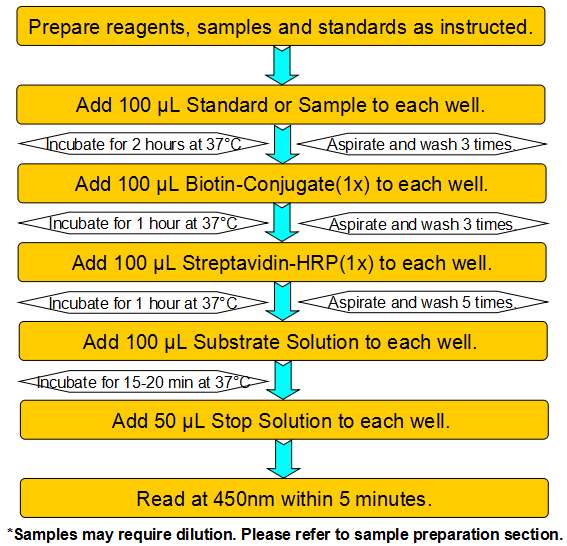Product Details
| Species Reactivity |
General |
| UniProt |
N/A |
| Abbreviation |
OVA |
| Alternative Names |
N/A |
| Range |
Request Information |
| Sensitivity |
Request Information |
| Sample Type |
Serum, Plasma, Other biological fluids |
| Detection Method |
Competitive |
| Analysis Method |
Quantitive |
| Assay Duration |
1-4.5h |
| Sample Volume |
1-200 μL |
| Detection Wavelengt |
450 nm |
Test principle
This assay employs the indirect competitive inhibition enzyme immunoassay technique. The microtiter plate provided in this kit has been pre-coated with OVA. Standards or samples are then added to the appropriate microtiter plate wells with a Horseradish Peroxidase (HRP)-conjugated antibody specific for OVA and incubated. Following a wash to remove any unbound avidin-enzyme reagent, a substrate solution is added to the wells and color develops in proportion to the amount of OVA bound in the initial step. The color development is stopped and the intensity of the color is measured.
Product Overview
Ovalbumin is the main protein found in egg white, making up 60-65% of the total protein. While Ovalbumin displays sequence and three-dimensional homology to the serpin superfamily, it is a noninhibitory serpin. While most serpins control such processes as fibrinolysis and coagulation by inhibiting serine proteases, the function of ovalbumin is unknown, although it is presumed to be a storage protein. The ovalbumin protein of chickens is made up of 385 amino acids, and its relative molecular mass is 45 kDa. It is a glycoprotein with 4 sites of glycosylation. It is secreted from the cell. Unlike the signal sequences of most secreted proteins, Ovalbumin's signal sequence is not cleaved. Additionally it is not located directly on the N-terminus, but rather internally, starting at residue 21 and ending at residue 47.
Components
Reagents |
Quantity |
Reagents |
Quantity |
Assay plate (96 Wells) |
1 |
Instruction manual |
1 |
Standard (lyophilized) |
2 |
Sample Diluent |
1 x 20 mL |
Biotin-Conjugate (concentrate 100 x) |
1 x 120 μL |
Biotin-Conjugate Diluent |
1 x 12 mL |
Streptavidin-HRP (concentrate 100 x) |
1 x 120 μL |
Streptavidin-HRP Diluent |
1 x 12 mL |
Wash Buffer (concentrate 25 x) |
1 x 20 mL |
Substrate Solution |
1 x 10 mL |
Stop Solution |
1 x 6 mL |
Adhesive Films |
4 |
Specificity
This assay has high sensitivity and excellent specificity for detection of OVA. No significant cross-reactivity or interference between OVA and analogues was observed.
Recovery
Matrices listed below were spiked with certain level of recombinant OVA and the recovery rates were calculated by comparing the measured value to the expected amount of OVA in samples.
Precision
Intra-assay Precision (Precision within an assay) Three samples of known concentration were tested twenty times on one plate to assess intra-assay precision. Inter-assay Precision (Precision between assays) Three samples of known concentration were tested in forty separate assays to assess inter-assay precision. CV (%) = SD/meanX100 Intra-Assay: CV<8% Inter-Assay: CV<12%
Linearity
The linearity of the kit was assayed by testing samples spiked with appropriate concentration of OVA and their serial dilutions. The results were demonstrated by the percentage of calculated concentration to the expected.
Stability
The stability of ELISA kit is determined by the loss rate of activity. The loss rate of this kit is less than 5% within the expiration date under appropriate storage condition. The loss rate was determined by accelerated thermal degradation test. Keep the kit at 37°C for 4 and 7 days, and compare O.D.values of the kit kept at 37°C with that of at recommended temperature. (referring from China Biological Products Standard, which was calculated by the Arrhenius equation. For ELISA kit, 4 days storage at 37°C can be considered as 6 months at 2 - 8°C, which means 7 days at 37°C equaling 12 months at 2 - 8°C).
Sample collection and storage
Serum: Use a serum separator tube (SST) and allow samples to clot for two hours at room temperature or overnight at 2 - 8°C before centrifugation for 15 minutes at 1000 × g. Remove serum and assay immediately or aliquot and store samples at ≤ -20°C. Avoid repeated freeze-thaw cycles. Plasma: Collect plasma using EDTA, or heparin as an anticoagulant. Centrifuge for 15 minutes at 1000 × g at 2 - 8°C within 30 minutes of collection. Assay immediately or aliquot and store samples at ≤ -20°C. Avoid repeated freeze-thaw cycles.
Other biological fluids: Centrifuge samples for 20 minutes at 1000 × g. Remove particulates and assay immediately or store samples in aliquot at -20°C or -80°C. Avoid repeated freeze/thaw cycles.
Kits storage instructions
Store at 2-8°C. Please refer to Instruction Manual.



